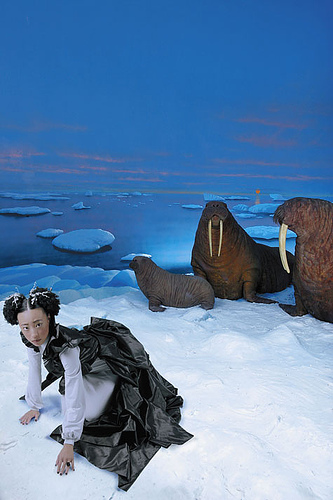One article I like to use when teaching about colonialism is Ann Stoler’s “Carnal Knowledge and Imperial Power” from di Leonardo’s Gender at the Crossroads of Knowledge. There is a book length version of the argument as well, but the article does the job. (It works very nicely together with Claire Denis’ film Chocolat)
Central to Stoler’s argument is the claim that colonial policy towards marriages between colonial officers and native wives changed when the mixed-race children began to blur the color line that legitimated European rule. She looks at how in Indonesia, India, and elsewhere, the colonial governments began a policy of encouraging officers to bring wives from home, and how the presence of these wives then created new tensions as a result of the perceived need to protect these women from sexual assault. (The number of people executed for attempted rape does not match any changes in the number of such assaults actually reported.)
It was with this discussion in mind that the following account of changes in Indian colonial rule from William Dalrymple caught my eye:
During the 18th century it was almost as common for westerners to take on the customs, and even the religions, of India, as the reverse. These white Mughals had responded to their travels in India by shedding their Britishness like an unwanted skin, adopting Indian dress, studying Indian philo sophy, taking harems and copying the ways of the Mughal governing class they came to replace – what Salman Rushdie, talking of modern multiculturalism, has called “chutnification”. By the end of the 18th century one-third of the British men in India were leaving their possessions to Indian wives.
In Delhi, the period was symbolised by Sir David Ochterlony, the British Resident, who arrived in the city in 1803: every evening, all 13 of his Indian wives went around Delhi in a procession behind their husband, each on the back of her own elephant. For all the humour of this image, in such mixed households, Islamic customs and sensitivities were clearly understood and respected. One letter, for example, recorded that “Lady Ochterlony has applied for leave to make the Hadge to Mecca”. Indeed, Ochterlony strongly considered bringing up his children as Muslims, and when his children by his chief wife, Mubarak Begum, had grown up, he adopted a child from one of the leading Delhi Muslim families.
Dalrymple’s account of the reasons for this change are not at odds with those of Stoler, but the emphasis is different. On the one hand he attributes it to the “rise of British power” which “quickly led to undisguised imperial arrogance,” but he also attributes it to the “ascendancy of evangelical Christianity, and the profound change in social, sexual and racial attitudes that this brought about”:
The wills written by dying East India Company servants show that the practice of cohabiting with Indian bibis quickly declined: they turn up in one in three wills between 1780 and 1785, but are present in only one in four between 1805 and 1810. By the middle of the century, they have all but disappeared. In half a century, a vibrantly multicultural world refracted back into its component parts; children of mixed race were corralled into what became in effect a new Indian caste – the Anglo-Indians – who were left to run the railways, posts and mines.
The focus of Dalrymple’s article is actually on the 1857 mutiny and the parallels to the current situation in Iraq. It is a taste of his new book The Last Mughal.
(via Arts and Letters Daily)
